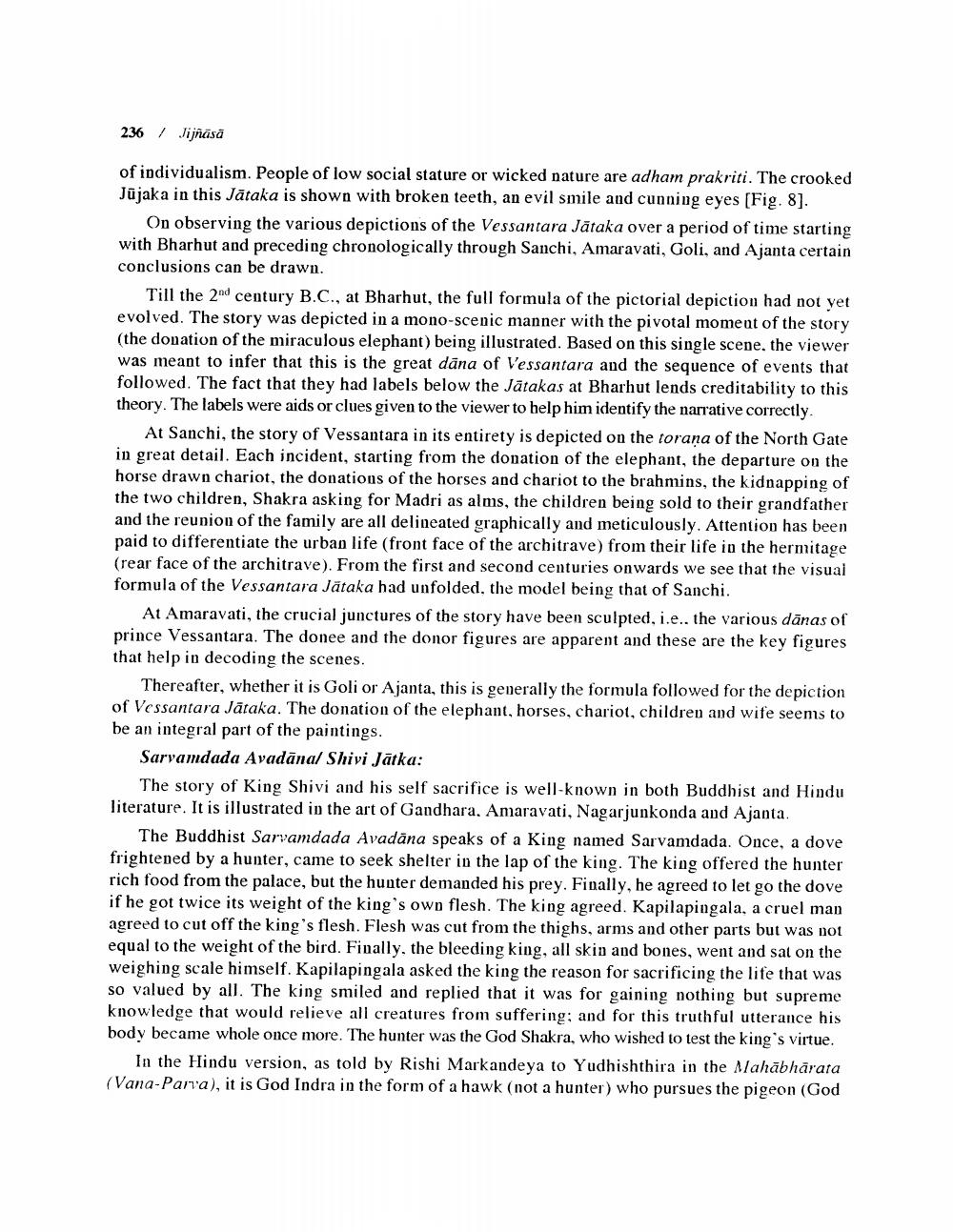________________
236
/
Jijnäsä
of individualism. People of low social stature or wicked nature are adham prakriti. The crooked Jūjaka in this Jātaka is shown with broken teeth, an evil smile and cunning eyes [Fig. 8).
On observing the various depictions of the Vessantara Jātaka over a period of time starting with Bharhut and preceding chronologically through Sanchi, Amaravati, Goli, and Ajanta certain conclusions can be drawn.
Till the 2nd century B.C., at Bharhut, the full formula of the pictorial depiction had not yet evolved. The story was depicted in a mono-scenic manner with the pivotal moment of the story (the donation of the miraculous elephant) being illustrated. Based on this single scene, the viewer was meant to infer that this is the great dana of Vessantara and the sequence of events that followed. The fact that they had labels below the Jätakas at Bharhut lends creditability to this theory. The labels were aids or clues given to the viewer to help him identify the narrative correctly.
At Sanchi, the story of Vessantara in its entirety is depicted on the torana of the North Gate in great detail. Each incident, starting from the donation of the elephant, the departure on the horse drawn chariot, the donations of the horses and chariot to the brahmins, the kidnapping of the two children, Shakra asking for Madri as alms, the children being sold to their grandfather and the reunion of the family are all delineated graphically and meticulously. Attention has been paid to differentiate the urban life (front face of the architrave) from their life in the hermitage (rear face of the architrave). From the first and second centuries onwards we see that the visuai formula of the Vessantara Jätaka had unfolded, the model being that of Sanchi.
At Amaravati, the crucial junctures of the story have been sculpted, i.e., the various dānas of prince Vessantara. The donee and the donor figures are apparent and these are the key figures that help in decoding the scenes.
Thereafter, whether it is Goli or Ajanta, this is generally the formula followed for the depiction of Vessantara Jātaka. The donation of the elephant, horses, chariot, children and wife seems to be an integral part of the paintings.
Sarvamdada Avadāna/ Shivi Jātka:
The story of King Shivi and his self sacrifice is well-known in both Buddhist and Hindu literature. It is illustrated in the art of Gandhara, Amaravati, Nagarjunkonda and Ajanta.
The Buddhist Sarvamdada Avadāna speaks of a King named Sarvamdada. Once, a dove frightened by a hunter, came to seek shelter in the lap of the king. The king offered the hunter rich food from the palace, but the hunter demanded his prey. Finally, he agreed to let go the dove if he got twice its weight of the king's own flesh. The king agreed. Kapilapingala, a cruel man agreed to cut off the king's flesh. Flesh was cut from the thighs, arms and other parts but was not equal to the weight of the bird. Finally, the bleeding king, all skin and bones, went and sat on the weighing scale himself. Kapilapingala asked the king the reason for sacrificing the life that was so valued by all. The king smiled and replied that it was for gaining nothing but supreme knowledge that would relieve all creatures from suffering; and for this truthful utterance his body became whole once more. The hunter was the God Shakra, who wished to test the king's virtue.
In the Hindu version, as told by Rishi Markandeya to Yudhishthira in the Mahābhārata (Vana-Parra), it is God Indra in the form of a hawk (not a hunter) who pursues the pigeon (God




